"A film covering a motor journey made by members of the Automobile Club of Southern California during the summer of 1930.... The Land of the Golden Twilight was northern British Columbia, and the tour left from Seattle, travelling through the Cariboo to Hazelton and Kispiox. Scenes included the Stampede at Williams Lake, a dance by medicine men, and many scenic views of northern British Columbia along the highway." (Colin Browne, Motion Picture Production in British Columbia, 1898-1940 (1979), entry #1052.)
The film is listed in Browne's filmography as "With the International Caravan to the Land of the Golden Twilight."
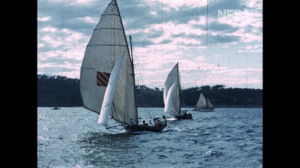
"Semi-professional documentary made in a romantic style as a tribute to Sydney Harbour and the different types of vessels that cruise on it." NFSA.
"JAMES A. SHERLOCK, S.A.C, Sydney, Australia, with his "To the Ships of Sydney," is the winner of the grand prize of $200 in the American Cinematographer's 1937 International amateur competition for 8mm and 16mm films. Under the terms of the gift of $100 in merchandise by Bell and Howell, to go to the maker of the film which in the opinion of the judges was the best in photographic technique of those films made entirely with Bell and Howell cameras, the man Down Under automatically comes in for a second award." American Cinematographer, Jan. 1938, 26.
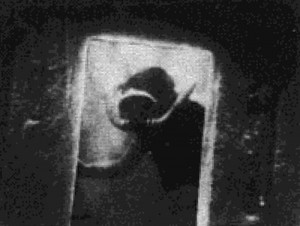
"Tobermory Shipwrecks provides some good views of sunken ships in the Tobermory region, located at the northern tip of the southern Ontario peninsula that separates Lake Huron from Georgian Bay. Much of the underwater photography is well done, and the producer gives tips on underwater photographic equipment and how to use it" PSA Journal, Sept. 1965, 51.
"The Toilers, a 150 ft. Kodacolor reel made by Arthur G. Greaves, demonstrates the continuity possibilities of Kodacolor, a much neglected aspect of amateur color movies. Men at work — in the harbors, along the seacoast and inland, caring for flocks and harvesting grain — is the motif of the picture, relieved by a few glimpses of men and children at play. The picture is distinguished by beautiful photography of consistent quality and by a smooth succession of moving compositions in color. These qualities, combined with a clear continuity, give the film much more unity than is usual with Kodacolor reels. This is one of the all too few Kodacolor films that may be viewed as a subject possessing an artistic purpose as a whole, rather than as a series of separate scenes and sequences. Its chief color triumph is, perhaps, in the scenes of the harvesting against the background of fields of golden grain." Movie Makers, Dec. 1931, 658.
"Coastal people, places and scenery between Vancouver Island and the mainland. Includes footage of Indian villages, pictographs, birds and wildlife, logging operations, other vessels, etc. One sequence shows a Kelly raft of aviation spruce being broken up; another shows logs being unloaded from the log barge 'Monongahela' (formerly the ship 'Balasore', whose figurehead is shown sitting on shore). The B.C. Packers cannery at Quathiaski Cove is shown. Troops arrive at Nanaimo from Vancouver on the 'Princess Victoria' and parade through the streets" British Columbia Archives.
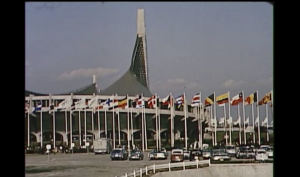
"The Tokyo Olympics, 1964 takes us to Tokyo and the Olympic games and provides us with a ringside seat for the numerous events that composed this athletic activity. Bad weather cannot be helped in a work of this kind, but the results in this picture did not suffer because of any inclement weather. For cut-aways we see the Emperor of Japan in his box, the smiling faces of the Orientals in the audience, and even an occasional glimpse of the cold drink hustlers charging 50 yen for a bottle of Coca Cola" PSA Journal, Sept. 1965, 51.
"Brickett Bridge, Andover Maine was built in 1871 of native spruce lumber. It served its purpose well until 1948 when it was replaced with steel and concrete." oldfilm.org
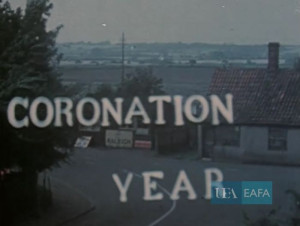
‘Camera pans over cottages in the village of Tolleshunt D’Arcy. Paintings of the coronation are shown followed by a photo of Queen Elizabeth II. A shot of the church with two old men sitting on a bench by the road. Another shot of the church followed by a sign post for the village and the Union Jack flag flying. A man goes into a telephone box in the middle of the village as a bus drives past. Flags and bunting decorate the village. Two women come out of a shop. One woman gets onto a bike and the other walks away. There is a shot of Tolleshunt D’Arcy Post Office and the postmistress, Miss Blaxhall, comes out under the filmmaker Joyce Allingham's direction. The baker puts up coronation decorations outside his shop and people put decorations on string around the village. A little girl waves a Union Jack flag. Close up of a girl and boy decorating pots using red, white and blue ribbon. Shots of people decorating their gardens. Two people come out of a Co-operative store and a little girl walks down the street carrying a basket. Mr and Mrs Emeny come out of the Thatcher’s Arms and another couple walk out of the front door of their cottage and smile at the camera. A woman wraps red, white and blue ribbon around her bird table and another woman carries a crown on a pillow. Camera pans across the street to show the villagers decorating. Children play in the street and a father lifts his little girl up to the camera and they both wave. People stand in a group and look at the camera. Miss Jessie Bacon looks through the window of Salter Lodge. Shot of the decorated D’Arcy Motors garage. The owner stands outside the garage where the Castrol oil and Esso petrol is sold. The proprietor, his wife and dog stand outside the Red Lion pub. Joyce’s sister, Margaret Allingham, and Margaret's husband, Philip Youngman Carter, stand outside their home in the main street. They then pose by the front door of D’Arcy House. Shot of a dog sitting in the garden. Close up of a woman hanging her washing on the line. Various shots of villagers going to church. A woman and her two children stand outside their home looking at the camera. A man climbs up a ladder to put up some bunting. Various villagers pose for the camera outside their homes and shops. One man cuts a rose and smells it. A car drives along the road followed by a shot of people coming out of a village shop. Shot of people looking out of the windows of the Queens Head pub and standing outside the tobacconist shop. Various shots of villagers standing outside shops and houses. A poster introducing the Tolleshunt D’Arcy Coronation Celebrations, June 2nd 1953 at the grounds of D’Arcy House. The poster states that there is a television in the village by Radio Vision, Maldon. It gives the line up of events for the day: Parade meet at The Maypole at 1.40pm followed by 3.45pm Sports; 4:30pm Sit Down Tea For Children; 5.00pm Running Buffet For Everyone; 5.40pm Sports Continued; 7.15pm Presentation of Prizes; 8.30pm Dancing in The Village. The procession of decorated lorries, vans, prams, cycles and fancy dress is shown. Camera pans over the people in the crowd dressed up in costumes. Close ups of the carnival floats driving past the camera. Children participate in various relay races. The film ends with scenes of a pram race with men dressed as women and the adult 'babies' drinking pints of beer’ (EAFA).
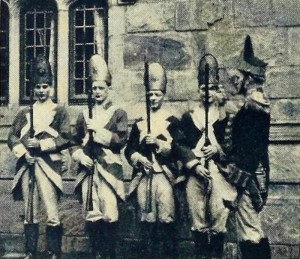
"Tom Jones, about 5000 ft., 16 mm, produced by the Purity Players of Yale University under the direction of S. Winston Childs, is the first amateur super-feature. The story is based on Fielding's Tom Jones and adheres with remarkable faithfulness to this famous novel, while many of the sets and costumes exhibit a care and an historical accuracy that has not since been equaled in amateur work. To those who have interest in 18th century literature, the picture will be particularly valuable." Movie Makers, Sept. 1930, 569.
Total Pages: 299